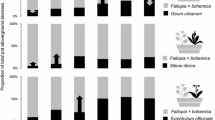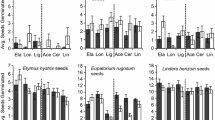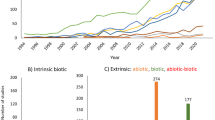Abstract
The primary aim of this paper is to discuss the methodological approaches that may best develop studies of allelopathy in the future. Laboratory studies on the functions of isolated chemicals, no matter how mechanistically detailed, cannot demonstrate the significance of allelopathy in communities. Evidence for allelopathy in natural plant communities should include information of concentrations and release rates such as demonstrated in field soils for (±)-catechin and Centaurea maculosaLam. Community-relevant evidence for allelopathy should include some manipulation of exudates such as performed in many experiments with activated carbon and gel filtration columns. Realistic evidence for allelopathy should include separation of resource effects from chemical effects; such as demonstrated by experiments with activated carbon additions, density-dependent responses to additions of competitors and chemicals, and resource addition treatments. Community-relevant evidence should link laboratory effects to field patterns and experiments; such as the links between the inhibitory effects of roots of Larrea tridentataCov., the highly spatially segregated root systems and regular above-ground spacing of this species, strong spatial disassociation of L. tridentata with other species, and removal experiments indicating that segregation of L. tridentata root systems via allelopathy may feed back to sequestering of resource use. Studies of allelopathy should consider chemically initiated shifts in microbial populations, and the effects of organic and inorganic soil components on the function of exudates; which has been done in a number of studies. Finally, studies of allelopathy should include large-scale manipulation of chemical effects; such as performed in field experiments in boreal forests in Sweden with Empetrum hermaphroditumHagerup and Scots pine (Pinus sylvestrisL.). Demonstrating the occurrence and importance of chemically mediated interactions among plants is not trivial. If even a small portion of the thousands of chemicals produced by different plant species have effects on their neighbours, then species-specific interactions, natural selection, community integration, and community coevolution may be quite different than predicted by conceptual models based solely on resource competition. Appropriate methodology is crucial for integrating chemically mediated interactions into ecological theory.
Similar content being viewed by others
References
Bais H P, Loyola-Vargas V M, Flores H E and Vivanco J M 2001 Root-specific metabolism: the biology and biogeochemistry of underground organs. In Vitro Cell Dev. Biol. Plant 37, 730–741.
Bais H P, Walker T S, Stermitz F R, Hufbauer R A and Vivanco J M 2002 Enantiomeric-dependent phytotoxic and antimicrobial activity of (±)-catechin. A rhizosecreted racemic mixture from spotted knapweed. Plant Physiol. 128, 1173–1179.
Bartholomew B 1970 Bare zone between California shrub and grassland communities: the role of animals. Science 170, 1210–1212.
Bever J D and Morton J B 1996 Host-dependent sporulation and species diversity of arbuscular mycorrhizal fungi in a mown grassland. J. Ecol. 84, 71–82.
Blum U 1995 The value of model plant-microbe-soil systems for understanding processes associated with allelopathic interactions: one example. In Allelopathy: Organisms, Processes and Applications. Eds. Inderjit, K M M Dakshini and F A Einhellig. pp. 127–131. American Chemical Society, Washington, DC.
Blum U 1999 Designing laboratory plant debris-soil bioassays: some reflections. In Principles and Practices in Plant Ecology: Allelochemical Interactions. Eds. Inderjit, K M M Dakshini and C L Foy. pp. 17–23. CRC Press, Boca Raton, FL.
Blum U, Shafer S R and Lehman M E 1999 Evidence for inhibitory allelopathic interactions involving phenolic acids in field soils: concepts vs. experimental model. Crit. Rev. Plant Sci. 18, 673–693.
Blum U, Staman K L, Flint L J and Shafer S R 2000 Induction and/or selection of phenolic acid-utilizing bulk-soil and rhizosphere bacteria and their influence on phenolic acid phytotoxicity. J. Chem. Ecol. 26, 2059–2078.
Brisson J and Reynolds J F 1994 The effect of neighbours on root distribution in a creosote bush (Larrea tridentata) population. Ecology 75, 1693–1702.
Callaway R M and Aschehoug E T 2000 Invasive plant versus their new and old neighbors: a mechanism for exotic invasion. Science 290, 521–523.
Callaway R M, Nadkarni N M and Mahall B E 1991 Facilitating and interfering effects of Quercus douglasii in central California. Ecology 72, 1484–1499.
Cheremisinoff P N and Ellerbusch F 1978 Carbon Adsorption Handbook. Ann Arbor Science Publishers, Ann Arbor, MI.
Del Moral R, Willis R J and Ashton D H 1978 Suppression of coastal heath vegetation by Eucalyptus baxteri. Aust. J. Bot. 26, 203–219.
Einhellig F A 1999 An integrated view of allelochemicals amid multiple stresses. In Principles and Practices in Plant Ecology: Allelochemical Interactions. Eds. Inderjit, K M M Dakshini and C L Foy. pp. 479–494. CRC Press, Boca Raton, FL.
Fischer N H, Williamson G B, Weidenhamer J D and Richardson D R 1994 In search of allelopathy in the Florida scrub: the role of terpenoids. J. Chem. Ecol. 20, 1355–1380.
Fonteyn P J and Mahall B E 1981 An experimental analysis of structure in a desert plant community. J. Ecol. 69, 883–896.
Fuerst E P and Putnam A R 1983 Separating the competitive and allelopathic components of interference: theoretical principles. J. Chem. Ecol. 9, 937–944.
Harper J L 1994 Population Biology of Plants. Academic Press, London.
Hierro J L and Callaway R M 2003 Allelopathy and exotic plant invasion. Plant Soil (accepted).
Hutto R L, McAuliffe J R and Hogan L 1986 Distributional associates of the saguaro (Carnegiea gigantea). Southwest. Nat. 31, 469–476.
Inderjit and Dakshini K M M 1995 On laboratory bioassays in allelopathy. Bot. Rev. 61, 28–44.
Inderjit and Dakshini K M M 1996a Allelopathic potential of well water from Pluchea lanceolata-infested cultivated fields. J. Chem. Ecol. 22, 1123–1131.
Inderjit and Dakshini K M M 1996b Allelopathic potential of Pluchea lanceolata: comparative study of cultivated fields. Weed Sci. 44, 393–396.
Inderjit and Del Moral R 1997 Is separating resource competition from allelopathy realistic? Bot. Rev. 63, 221–230.
Inderjit and Nilsen E T 2003 Bioassays and field studies for allelopathy in terrestrial plants: progress and problems. Crit. Rev. Pl. Sci. 22, 221–238.
Inderjit and Weiner J 2001 Plant allelochemical interference or soil chemical ecology? Perspect. Plant Ecol. Evol. Syst. 4, 4–12.
Inderjit and Weston L A 2000 Are laboratory bioassays for allelopathy suitable for prediction of field responses? J. Chem. Ecol. 26, 2111–2118.
Inderjit and Weston L A 2003 Root exudates: an overview. In Root Ecology. Eds. H de Kroon and E J W Visser. pp. 235–255. Springer, Heidelberg.
Inderjit, Foy C L and Dakshini K M M 1998 Pluchea lanceolata: a noxious weed. Weed Technol 12, 190–193.
Inoye B and Stinchcombe J R 2001 Relationships between ecological interaction modifications and diffuse coevolution: similarities, differences, and causal links. Oikos 95, 353–360.
Kaminsky R 1981 The microbial origin of the allelopathic potential of Adenostoma fasiculatum H & A. Ecol. Monogr. 51, 365–382.
Katz D A, Sneh B and Friedman J 1987 The allelopathic potential of Coridothymus capitatus L. (Labiatae). Preliminary studies on the roles of the shrub in the inhibition of annuals germination and/or to promote allelopathically active actinomycetes. Plant Soil 98, 53–66.
Mahall B E and Callaway R M 1991 Root communication among desert shrubs. Proc. Natl. Acad. Sci. USA 88, 874–876.
Mahall B E and Callaway R M 1992 Root communication mechanisms and intracommunity distributions of two Mojave desert shrubs. Ecology 73, 2145–2151.
McAuliffe J R 1988 Markovian dynamics of simple and complex desert plant communities. Am. Nat. 131, 459–490.
Muller C H, Muller W H and Haines B L 1964 Volatile growth inhibitors produced by aromatic shrubs. Science 143, 471–473.
Nilsson M C 1994 Separation of allelopathy and resource competition by the boreal dwarf shrub Empetrum hermaphroditum. Oecologia 98, 1–7.
Nilsson M C, Hogberg P, Zackrisson O and Fengyou W 1993 Allelopathic effects by Empetrum hermaphroditum on development and nitrogen uptake by roots and mycorrhizae of Pinus sylvestris. Can. J. Bot. 71, 620–628.
Nilsson M C, Gallet C and Wallstedt A 1998 Temporal variability of phenolics and batatasin-III in Empetrum hermaphroditum leaves over an eight-year period: interpretations of ecological functions. Oikos 81, 6–16.
Nilsson M C, Zackrisson O, Sterner O and Wallstedt A 2000 Characterization of the differential interference effects of two boreal dwarf shrub species. Oecologia 123, 122–128.
Oden P C, Brandtberg P O, Andersson R, Gref R, Zackrisson O and Nilsson M C 1992 Isolation and characterization of a germination inhibitor from leaves of Empetrum hermaphroditum Hagerup. Scand. J. For. Res. 7, 497–502.
Panetta F D and Wardle D A 1992 Gap size and regeneration in a New Zealand dairy pasture. Aust. J. Ecol. 17, 169–175.
Pue K J, Blum U, Gerig T M and Shafer S R 1995 Mechanism by which noninhibitory concentrations of glucose increase inhibitory activity of p-coumaric acid on morning-glory seedling biomass accumulation. J. Chem. Ecol. 21, 833–847.
Ridenour W M and Callaway R M 2001 The relative importance of allelopathy in interference: the effect of an invasive weed on a native bunchgrass. Oecologia 126, 444–450.
Romeo J T and Weidenhamer J D 1998 Bioassays for allelopathy in terrestrial plants. In Methods in Chemical Ecology. Vol. 2. Bioassay Methods. Eds. K F Haynes and J G Millar. pp. 179–211. Kluwer Academic Publishers, Norvell, MA.
Schenk H J, Callaway R M and Mahall B E 1999 Spatial root segregation: are plants territorial? Adv. Ecol. Res. 28, 146–180.
Schmidt S K and Ley R E 1999 Microbial competition and soil structure limit the expression of phytochemicals in nature. In Principles and Practices in Plant Ecology: Allelochemical Interactions. Eds. Inderjit, K M M Dakshini and C L Foy. pp. 339–351. CRC Press, Boca Raton, FL.
Schreiner O and Reed H S 1907 The production of deleterious excretions by roots. Bull. Torrey Bot. Club 34, 279–303.
Staman K, Blum U, Louws F and Robertson D 2001 Can simultaneous inhibition of seedling growth and stimulation of rhizosphere bacterial populations provide evidence for phytotoxin transfer from plant residues in the bulk soil to the rhizosphere of sensitive species? J. Chem. Ecol. 27, 807–829.
Stephan A and Meyer A H 2000 Plant diversity affects culturable soil bacteria in experimental grassland communities. J. Ecol. 88, 988–998.
Thijs H, Shann J D and Weidenhamer J D 1994 The effect of phytotoxins on competitive outcome in a model system. Ecology 75, 1959–1964.
Wardle D A, Nicholson K S, Ahmed M and Rahman A 1994 Interference effects of the invasive plant Carduus nutans L. against the nitrogen fixation ability of Trifolium repens L. Plant Soil 163, 287–297.
Wardle D A, Nicholson K S, Ahmed M and Rahman A 1995 Influence of pasture forage species on seedling growth emergence, growth and development of Carduus nutans. J. Appl. Ecol. 32, 225–233.
Wardle D A, Nilsson M C, Gallet C and Zackrisson O 1998a An ecosystem level perspective of allelopathy. Biol. Rev. 73, 305–319.
Wardle D A, Zackrisson O and Nilsson M C 1998b The charcoal effect in boreal forests: mechanisms and consequences. Oecologia 115, 419–426.
Weidenhamer J D 1996 Distinguishing resource competition and chemical interference: overcoming the methodological impasse. Agron. J. 88, 866–875.
Weidenhamer J D and Romeo J T 1989 Allelopathic properties of Polygonella myriphylla: field evidence and bioassays. J. Chem. Ecol. 15, 1957–1970.
Weidenhamer J D, Hartnett D C and Romeo J T 1989 Densitydependent phytotoxicity: distinguishing resource competition and allelopathic interference in plants. J. Appl. Ecol. 26, 613–624.
Williamson G B 1990 Allelopathy, Koch's postulates, and the neck riddle. In Perspectives on Plant Competition. Eds. J B Grace and D Tilman. pp. 143–162. Academic Press, San Diego, CA.
Williamson G B and Weidenhamer J D 1990 Bacterial degradation of juglone: evidence against allelopathy? J. Chem. Ecol. 16, 1739–1742.
Zackrisson O, Nilsson M C, Wardle D A 1996 Key ecological function from wildfire in Boreal forest. Oikos 77, 10–19.
Author information
Authors and Affiliations
Corresponding author
Rights and permissions
About this article
Cite this article
Inderjit, Callaway, R.M. Experimental designs for the study of allelopathy. Plant and Soil 256, 1–11 (2003). https://doi.org/10.1023/A:1026242418333
Issue Date:
DOI: https://doi.org/10.1023/A:1026242418333




